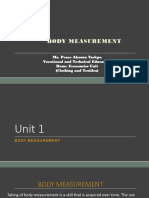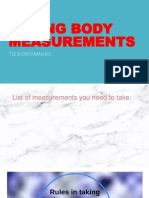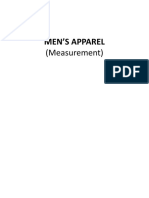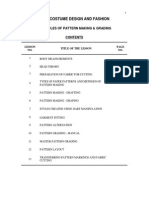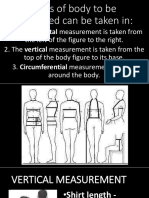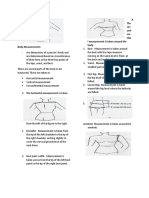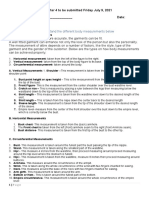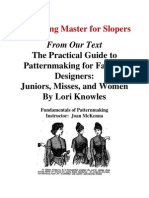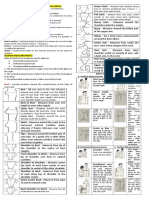0 ratings0% found this document useful (0 votes)
25 views14 pagesUnit 3
Body measurements
Uploaded by
Prema LCopyright
© © All Rights Reserved
We take content rights seriously. If you suspect this is your content, claim it here.
Available Formats
Download as PDF or read online on Scribd
0 ratings0% found this document useful (0 votes)
25 views14 pagesUnit 3
Body measurements
Uploaded by
Prema LCopyright
© © All Rights Reserved
We take content rights seriously. If you suspect this is your content, claim it here.
Available Formats
Download as PDF or read online on Scribd
You are on page 1/ 14
UNIT3 BODY MEASUREMENTS
Structure
3.0. Objectives
3.1 Introduction
3.2 Measurements
3.2.1 Guidelines for Measurement Taking
3.2.2 Process of Taking Measurement
3.3. Size Charts
3.3.1 Importance of Size Charts
3.4 Standard Body Measurements
3.5. Let Us Sum Up
3.6 Keywords
3.7 References and Suggested Readings
3.8 Check Your Progress: The Key
3.0 OBJECTIVES
After going through this unit, you should be able to:
Establish the importance of measurement taking.
© Identify guidelines for measurement taking,
© Identify body landmarks.
Take body measurements with the help of style tape and measuring tape.
3.1__ INTRODUCTION
We will discuss about the process of body measurements in this unit.All garments
were custom made and measurements were taken using traditional tools till the
19* centaury, These include a measuring tape and perhaps a style tape to mark
waistline. Measurements were taken along the contours of the body and by
identifying the body landmarks carefully (usually by feeling bones beneath the
skin), Till date this is the commonly used method for taking body measurements.
Body landmarks are identified points on the body which help in taking of
measurements.
The unit will help you identify body landmarks and further guide measurement
taking process. This unit will take two hours of study; and you may take more
time if you put in more time doing all the activities given inside the text. To
study this unit you will need your tools like measuring tape, L~ scale, pencil,
measurement chart and a dress form. If you don’t have a dress form you can take
measurements of your friend.
Introduction o Pattern Making
32
Apart from the traditional method; Anthropometries was introduced which is a
methodical and precise method of taking body measurements. The tools, which
are used, are referred to as anthropometers (which is a standing tool to measure
linears), calipers and calibrated measuring tapes to measure across and circular
measurements. The method is very time consuming and accuracy depends on
the expertise of personnel.
Recent technologies involve use of 3D body scanning which produces a 360-
degree view of object where the replica can be viewed, rotated and measured on
the computer screen. 3 D scans analyze body postures and proportions very easily
and is a time efficient and accurate method.
Box below gives an interesting example from Levis who is curently using 3 D
scanning.
‘The Intellifit Booth: a ‘sizing’ machine that works!
The high-tech Intellifit booth that measures a customer’s size by 3-D
scanning for a perfect fit has been on trial for almost a year. The booths.
which companies such as Levi’s are using as an attraction in stores and at
outdoor events, tell customers which sizes and styles of a particular brand
are likely to fit them best. Three-dimensional body scanners are not new,
but Intellifit’s innovation is to let shoppers get scanned fully clothed ina
clear plastic booth using radio waves instead of laser which works only
when the customer wears nothing or close fitting clothes.
In a test with 150 Levi’s customers, the scanners accurately predicted
best-fitting sizes 92 percent of the time. Customers apparently like the
technology enough to stand in line to try it. Retailers that have used the
scanners report that it boosts conversion by 20 to 50%. Women want the
scanner to make their trips to the dressing room more efficient, whereas
‘men want to skip trying on clothes altogether.
3.2__ MEASUREMENTS
Measurements are a very important element as the fit of any garment depends on
the patterns used, which in tur are dependent on the measurements, Measurement
taking is a scientific art that should be done with great accuracy and should be
double-checked. In this unit you will study the guidelines for measurement taking;
which will be followed by girth, vertical and horizontal measurements. Further
sleeve, skirt and trouser measurements are being discussed. Before you continue
it will be helpful to identify and locate body landmarks with the help of Figure
31
oe. iho Suter Post
| i
Wh)
vo | }
bbe
Front Back
Figure 3.1: Body Landmarks
Source: Google images
3.2.1 Guidelines for Taking Measurement
You can leam how to take measurements on a dress form or alternatively on a
person, You cannot take your own measurements but you can learn how to take
body measurements on you friend if dress forms are not accessible, To get accurate
results itis very important to follow the following guidelines:
»
2
3)
4)
3)
The person should wear close fitting garments, as loose fitting garments
will not help you identify body landmarks and lead to incorrect measurements.
The person should stand straight with the feet placed together; wrong posture
can give incorrect measurements.
Take all measurements closely but not too tight. All girth measurements
should be taken with finger ease between the tape and the body.
Itis best to take measurements with a mirror at the back; this will help you
to see the back view also. This will ensure that your measuring tape is parallel
to the floor.
Also ensure that while taking vertical measurements the tape is perpendicular
to the floor, All vertical measurements should be taken on one side only —
usually the right side of the body.
Body Measurements
Introduction o Pattern Making
34
6) It is best to follow a sequence and note down all the measurements
given Table no. 3.7.
Activity 1
Answer the following questions very briefly.
‘Compare your answer with the one given in the end of unit. Do you find
anything that you had not thought of?
1) Why is it important to take correct body measurements?
2) List down the tools required for taking body measurements?
3) What are the critical points to be considered while taking body
measurements?
3.2.2. Process of Taking Measurement
Measurements are basically divided into three categories:
© Girth measurements — Girth measurements include all round measurements
of the body like bust circumference, waist circumference etc.
© Horizontal measurements— Horizontal / width measurements are the across
‘measurements including across shoulder, shoulder length,
© Length measurements — These are the vertical measurements of the body
and include measurements like bodice length, skirt length, sleeve length
ete
Table 3.1: Girth Measurements
1. | Bust This measurement is taken around the fullest part of
circumference} the bust, Ensure that tape is parallel to floor and does
not slip down at the back. Measurement is taken by
inserting one finger in to hold the tape and no extra
ease is to be added.
2. | Waist
circumference
The measurement is taken around natural waistline,
which is normally one inch above the navel. Tie a
cord / elastic around the waist and let it settle at the
narrowest part, Measure completely around the waist.
To identify waist level ask the subject to bond
sideways. Feel the folds of flesh a chat in the waist
level.
Hip cireumference|
Measure around the fullest part of the hips. Hips are
approximately 21cm below the waistline for a UK
Size 12 medium height figure.
4. | Neck girth
Measure around the base of the neck over the collar
bone. Ensure that you measure with a thick thread
and not measuring tape. It is not possible to measure
the neck girth accurately on the body. Hence, it is
normally derived from the buch measure (This is
RB).
Source: Google images
Girth Measurements
Body Measurements
Introduction o Pattern Making
36
‘Table3. 2: Horizontal Measurements
1. | Actoss back
Back width measurement is measured from one
armhole to other over the shoulder blades. Across
back level is approximately 12cm below nape for a
UK Size 12 medium height figure
2. | Across chest
Measure from armhole to armhole in the front,
approximately 10cems below base of throat, This is
an important measurement for tight fitting garments.
3. | Shoulder length | Measure from highest shoulder point {HSP} (where
neck meets shoulder line) to the lowest shoulder point
{LSP} (where shoulder ends and arm begins) i
acromion bone at the end of the shoulder
4. | Across shoulder _| Measure from one lower shoulder point to other lower
shoulder point on the back body. Take care that tape
is passing over the back nape of the neck.
5. | Bust span
Measure from one apex point to the other apex point.
Figure 3.3: Horizontal Measurements
‘Table 3.3: Vertical Measurements
1. | Front length
Measure from HSP till waistline and pass
the tape over the bust as indicated in Figure
34.
2. | Centresfront length (CF) | Measure from base of the neck to natural
waistline. This measurement is taken on the
centre front bodyline,
3. | Centre-back length (CB) | Measure from nape of neck to waistline.
This is measured on the centre back line of
the body.
4. Highest shoulder point Measure from HSP to the centre of the
(HSP) to bust fullest part of the bust i.e, apex point
5. | Armhole depth’ Seye | Measure 2.5 em down from the armpit,
depth transfer this point to centre back line. Next,
measure on the centre back line from nape
down CB, to the marked armhole level.
Figure 3.4: Vertical measurements
Source: Google images
Table 3.4: Sleeve Measurements
1. | Sleeve Length Stand straight with arm resting on the hip level;
measure from lower shoulder point (where the
sleeve will be attached) to elbow to wrist bone,
2. | Under Arm Length _| Measure from under arm point to wrist level.
Armbole Girth
Place the arm in a normal rest position and
measure around armhole.
Bicep Circumference
Place your hand at the hip; measure around
the bicep at its fullest part.
Elbow Girth
Measure around elbow with the arm bent,
Wrist Circumference
Identify the prominent wrist bone and measure
just below around the wrist. Wrist measurement
is important for tight sleeve garments.
Hand Girth
Measure around widest part of hand.
Body Measurements
Introduction o Pattern Making
38
Figure 3.5: Sleeve measurements
Table 5: Skirt measurements
In addition to waist and hip measurement you are required to measure the
following. Vertical measurements for lower garments are taken from the waist
downwards to required loc:
‘ions.
1
High Hip level
High hip level is marked approx. 10cms below
waistline. This level is used to create low waisted
skirts or trousers. Measure around the high hip
level.
Waist to Hip Level
Identify the fullest part of hip and measure from
waist to hip.
Waist to knee length
‘Take the measurement from the waist to the knee
level,
Waist to ankle length
Measure from waistline to ankle level.
Figure 3.6: Skirt Measurements
Table 3.6: Trouser Measurements Body Measurements
In addition to waist, hip and waist to hip measurement you are required to
measure the following:
1. | Body rise/ Crotch Depth | Ask the subject being measured to sit on a
hard surface; identify the waist level with a
cord. Next take the measurement from waist
level to the seating surface.
2. | Inside leg length Tnseam is measured from crotch point to the
anklebone.
3. | Outside leg length Measure the out seam from waist, over hips
to anklebone. Take the measurement on the
side seam.
4. | Round Knee At knee level measure around the knee cap
(fullest part)
5, Round Ankle Measure around the ankle; just above the
most prominent anklebone.
Figure 3.7: Trouser Measurements
Source: Google images
Check Your Progress 2
1) _List the set of measurements required for making a basic bodice block with
asleeve.
Introduction o Pattern Making
40
2) Explain the set of measurements required for making a skirt block.
3.3. SIZE CHARTS
In the previous section, we discuss about the measurements. In this section we
will discuss about size charts.. To get a size chart sample population is measured
to get trustworthy data. Readymade garments are produced for masses that fall
in different sizes .A sizing system is based on body measurements taken on a
cross-section of population. The study of the sample population helps
manufacturers to produce garments, which provide a good fit for large number
of customers. An effective sizing system must cover the largest number of people
with the smallest number of size
The Indian ready to wear clothing section is based on the British standards. Size
charts reflect the size ranges that the manufacturer regards as his market. The
size charts show the measurement differences, or grade, between various sizes.
Different countries use different size intervals. And for that matter two different
manufactures in the same country might use different size charts, One
manufacturer might provide 5 sizes in a range of kurta from 8 - 10 -12- 14-16
and the second manufacturer decides to provide only 3 sizes i.e. small, medium
and large.
With the above information we can analyze that the first manufacturer is catering
to high-end market and therefore needs to keep sizes, which are close to body
structures and satisfy the consumer needs, Whereas the second manufacturer
appears to cater to a mass market and cannot afford to keep five sizes, as keeping
more stock increases his cost price. The second manufacturer knows that his
consumer will buy from three sizes by compromising a little on the fit but they
are more conscious of the price.
It may also happen that two different manufacturers are providing same size
range e.g, Small, Medium and Large but the fits are different, One reason could
be that the measurements used are same but pattern making processes are different;
‘one with more ease and other with less ease. This may be disagreeable to people
but it is a basic fact if two handwritings are different; two patterns from two
pattern masters need not be identical. Different fits can also result due to lack of
standardized size charts.
In Indian men's wear market size charts are more or less standardized and you
may find similar sizes and fits with different manufacturers. Whereas Indian
women's wear industry is still not following standard size charts. Various
government organizations are in the process of formulating size charts for the
country and in the near future we will have Indian size charts being followed by
all the manufacturers.
Size intervals
Size interval is the difference in measurements between two sizes. E.g. Size 10
round bust measurement is 84 cms and is 88 cms for size 12, the size interval is
4om.
3.3.1 Importance of Size Charts
Proper sizing is very important to the ready-to-wear garment industry because of
following reasons:
© Itallows the manufacturer to produce garments, which can fit the maximum
number of people.
«This helps the retailer to stack a suitable range of sizes in each style and thus,
cater to his market well.
© With proper size ranges, the customer is at an advantage as this increases
the chances of finding a garment in a size and style properly proportioned to
the figure, thus reducing the alterations required.
3.4 STANDARD BODY MEASUREMENTS
Table 3.8 provides an example of size charts used in UK. Notice carefully that in
one size chart difference in bust measurement is 4 cm between sizes 8 to 14 and
from size 16 onwards the difference is Sem.
Women of medium height 160cm - 170cm (5ft 2 1/2in - Sft 61/2 in)
The largest percentage of population falls into medium height range. Although
the girth of women varies, the general trend is for the weight to increase with
height. This feature is reflected in the size charts.
Table 3.
: Standard body measurements
Size 8 [10] 12 | 14 | 16 | 18 | 20 | 22 [24 | 26 | 28 | 30
Round Bust | 80 | 84 | 88 | 92 | 97 | 102 | 107 [112 | 117/122 | 127 | 132
Round Waist | 60 | 64 | 68 | 72 | 77 | 82 | 87 | 92 | 97 [102 | 107 | 112
Round Hip _| 85 | 89 | 93 | 97 | 102] 107 | 112 [117 | 122 [127 | 132 [137
Across Back |32.4|33.4]34.4 | 35.4 | 36.6] 37.8 | 39 [40.2 |41.4}42.6| 43.8 | 45
Across Chest] 30 [31.2]32.4| 33.6] 35 |36.5| 38 [39.5] 41 [42.5] 44 [45.5
Shoulder 11.75] 12 12.25] 12.5 | 12.8] 13.1 |13.4]13.7 | 14 [14.3] 14.6 [14.9
Neck size _| 35 | 36 | 37 | 38 |39.2/40.4]41.6]42.8 | 44 [45.2] 46.4 [47.6
Upper arm _| 26 |27.2|28.4| 29.6] 31 |32.8 [34.4] 36 |37.8)39.6| 41.4 [43.2
Wrist 15 |1s.s| 16 | 16.5] 17 |17.5| 18 ]18.s| 19 [19s] 20 J20.5
Ankle 23 |23.s| 24 | 24.5 | 25.1] 25.7 |26.3 26.9 |27.5 [28.1 | 28.7 |29.3,
High Ankle] 20 |20.5{ 21 | 21.5 [22.1] 22.7 [23.3 ]23.9 }24.5 5.1 [25.7 }26.3,
Nape to waist] 39 [39.5] 40 | 40.5] 41 [41.5] 42 ]42.5 | 43 [43.2] 43.4 43.6
Front Shouldef 39 [39.5] 40 | 40.5 | 41.3] 42.1 ]42.9]43.7 |aa.s] 45 [45.5] 46
to Waist
Body Measurements
4
Introduction to Pattern Making
Armhole | 20 [20.5] 21 [21.5] 22 |22.5] 23 [23.5 [24.2 [24.9] 25.6 [26.3
depth
Waistto {57.5} 58 |58.5] 59 | 59.5] 60 | 60.5] 61 1.25}61.5 }61.75] 62
knee
Waist to hip | 20 [20.3 ]20.6 | 20.9| 21.2/21.5 | 21.8 }22.1 |22.3 2.5 ]22.7 [22.9
Waistto | 102 ]103 ] 104] 105] 106] 107 | 108 | 109 fio9.s]110 110.5] 111
floor
Body rise _|26.6|27.3| 28 | 28.7] 29.4] 30.1 | 30.8]31.5 |32.5 33.5 ]34.5 ]35.5
Sleeve 57.2|57.8|58.4] 59 | 59.5] 60 | 60.5] 61 |61.2\61.4] 61.6 61.8
length
Sleeve 51.2|51.8]52.4] 53 | 53.5] 54 |54.5] 55 |55.2/55.4]55.6|55.8
length
Gersey)
Cuff Size, | 21 | 21 |21.5] 21.5] 22 22.5] 23 |23.s| 24 fpa.s] 25 |2s.s
Shirts
Cuff Size,
Two - pie
sleeve
13.25}13.5 13.75] 14 ]14.25 14.5 ]14.75] 15. [i5.25]15.5]15.75] 16
Trouser a1 ja1.s| 22 | 22.5) 23 }2:
Bottom
Width
24 |24.s |25.426.2| 27 27.8
Jeans 185/185] 19 | 19 | 19.5] 20 } 20.5} 21
Bottom
Width
Size Chart for tall or short women have each vertical measurement adjusted as
follow.
Short Women 152 - 160 em ] Tall Women 170 -178 em
(4f 11 4 in - 5821/2 in) | (6ft 61/2 in - $f 91/2 in)
Nape to Waist -2em +2cm
Scye Depth -0.8 em +0.8 om
Sleeve Length -2.5em +2.5em
Waist to Knee -3cm +3cm
Waist to Floor - Sem + Sem
Body Rise ~ lem +lem
Source: Aldrich, W. (1999) Metric Patten Cutting; Blackwell Science
Reading size charts carefully you can observe the following:
© Not all measurements increase by same amount.
© Measurements like round bust, waist and hip increase in the same proportion
and usually by 4 -5 cm,
© Measurements like across chest, across back increase only by 1 to 1.5 em.
© Shoulder measurements increases only marginally from 0.25 to 0.3 em.
42
3.5 LET US SUM UP
Measurement taking is an important and integral component in the making of
garments. In this unit you have learnt to identify the body landmarks correctly.
‘Measurements are categorized under three heads i.e. vertical, horizontal and girth
measurements, The key to get a right fit of any garment depends on the right
measurements so double check all your measurements. Table No. 8 provides an
example of UK size chart. You can use the table, as a reference chart to tally your
measurements to the size you are closest to in the size chart.
Measurement size charts are important information centers providing details of
a population. Size charts provide great deal of information to the designers,
‘manufacturers, retailers as well as to the consumers, Once you go through various
size charts you can easily identify which size category you fall in.
3.6 KEY WORDS
© Body Landmarks
Neck Circumference,
© Bust Circumference
© Waist Circumference
© Hip Circumference
© Across Shoulder
© Front Length,
3.7__REFERENCES AND SUGGESTED READINGS
¢ Shoben, Martin and Ward, J.P (1997). Pattern Cutting and Making up: The
Professional Approach. New Delhi: CBS Publishers.
© Aldrich, Winifred (1998) Metric Pattern Cutting for Women's Wear. London:
Blackwell Science.
© Armstrong, Helen Joseph (1995) Pattern Making for Fashion Design. New
York: Harper Collins College Publishers.
3.8 CHECK YOUR PROGRESS: THE KEY
1) Correct body measurements are very important to get right fit of the garments.
And getting a right fit is important to a designer, manufacturer as well as to
the customer.
1) Fortaking measurements you need a style tape to tie around waist, measuring,
tape, thick cord for neck measurements and a measurement chart and pen to
record the same.
2) Following points should be considered while taking body measurements:
The person should wear close fitting garments as loose fitting garments will
hinder locating body landmarks and lead to incorrect measurements.
The person should stand straight with the feet placed together
Take all measurements closely but not too tight
Body Measurements
43
Introductionto Pattern Making eI is best to take measurements with a mirror at the back. This will
ensure that your measuring tape is parallel to the floor.
Also ensure that while taking vertical measurements the tape is
perpendicular to the floor. All vertical measurements should be taken
on one side only - usually the right side of the body.
* tis best to follow a sequence and note down all the measurements in
the given Table no. 3.7 and 3. 9.
2) 1) Measurements required for a basic bodice block with sleeve are:
© Bust Circumference
© Waist Circumference
© Neck Girth
© Actoss Back
© Actoss Chest
© Shoulder Length
© Actoss Shoulder
© Front Length
© Centre-Front Length (CF)
© Centre-Back Length (CB)
Highest shoulder point (HSP) to bust
© Ambole depth
Sleeve Length
© Under Arm length
© Armbole Girth
* Bicep Circumference
© Elbow Girth
© Wrist Circumference
2) Measurements required for a skirt block are:
© Waist Circumference
© Hip Circumference
© High Hip level
© Waist to Hip level
© Waist to Knee length
© Waist to Ankle length
44
You might also like
- Lesson 3 - Taking Body Measurements Carry Out Measurements and CalculationsNo ratings yetLesson 3 - Taking Body Measurements Carry Out Measurements and Calculations13 pages
- Tools and Equipment Used in Garment Making: Easy Learning100% (1)Tools and Equipment Used in Garment Making: Easy Learning6 pages
- Carry Out Calculations and MeasurementsNo ratings yetCarry Out Calculations and Measurements35 pages
- TAKING BODY MEASUREMENTS G9 DressmakingNo ratings yetTAKING BODY MEASUREMENTS G9 Dressmaking32 pages
- He - Dressmaking G7 8 - Q1 - Module 3 4 FinalNo ratings yetHe - Dressmaking G7 8 - Q1 - Module 3 4 Final20 pages
- TLE 8 Dressmaking - Carrying Out Body Measurements100% (2)TLE 8 Dressmaking - Carrying Out Body Measurements13 pages
- The National Teachers College: A Semi-Detailed Lesson Plan in Technology and Livelihood EducationNo ratings yetThe National Teachers College: A Semi-Detailed Lesson Plan in Technology and Livelihood Education7 pages
- CDFT Banner 8x6 - 20250329 - 095902 - 0000No ratings yetCDFT Banner 8x6 - 20250329 - 095902 - 00001 page

